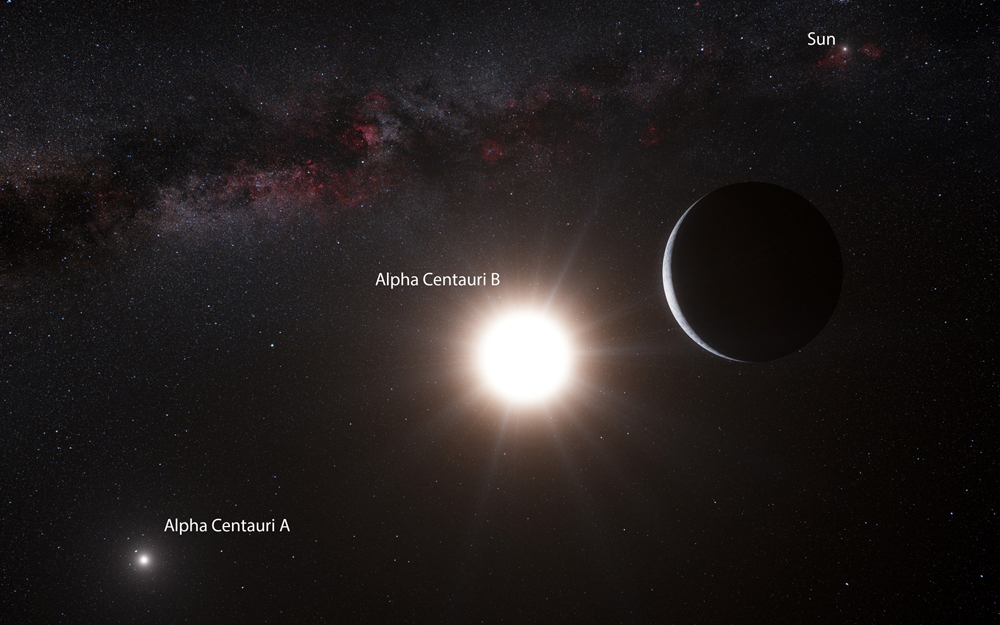Stephen Hawking's 'Starshot': 5 Fun Facts About Alpha Centauri

Earthlings may have left boot prints on the moon, but even nearby stars, such as the bright Alpha Centauri system, have long been out of reach.
That may not be the case for long.
Famed theoretical physicist Stephen Hawking, billionaire investor Yuri Milner and a panel of scientists announced today (April 12) that they plan to send hundreds, if not thousands, of tiny spaceships into space, toward Alpha Centauri. [Science Fact or Fantasy? 20 Imaginary Worlds]
The journey to the nearby star, located more than 4.3 light-years away, is expected to take just 20 years, the panelists said. These little spaceships would be wafer-size, and have lightweight sails that lasers on Earth would propel forward, Milner told reporters today.
It may be a generation before the project, called Breakthrough Starshot, takes off, but in the meantime, here are five weird facts about Alpha Centauri.
1. Alpha Centauri isn't a star
Alpha Centauri isn't a star, but a star system, according to NASA.
Get the world’s most fascinating discoveries delivered straight to your inbox.
The system has three stars. Proxima Centauri is the dimmest star and the closest to Earth. Alpha Centauri A and B, the other two stars, are brighter and form a binary system. But they aren't exactly close together.
The Earth is about 93 million miles (150 million kilometers) away from the sun. Alpha Centauri A and B are about 23 times that distance apart from one another, NASA said. That is a bit more than the distance between the sun and Uranus.
2. It's far away
Proxima Centauri is about 24,800,000,000,000 miles (39,900,000,000,000 km) away from Earth. This works out to about 4.22 light-years, meaning it would take 4.22 years to reach if we could somehow travel at the speed of light.
Alpha Centauri A and B are slightly farther away from Earth — about 4.35 light-years.
Breakthrough Starshot scientists are proposing spacecraft that would travel at 20 percent the speed of light. At that rate, it would take the tiny spaceships about 20 years, or a generation, to reach Alpha Centauri.
3. Alpha Centauri has a planet
In 2012, researchers announced that Alpha Centauri has an Earth-size planet orbiting Alpha Centauri B.
The planet appears to be scorched and rocky, but has about the same mass as the Earth. It circles Alpha Centauri B from a distance of about 3.6 million miles (6 million km), which suggests that it has a surface covered in molten lava, Live Science previously reported.
The planet, named Alpha Centauri Bb, could be evidence that another planet may be lurking in the star system, perhaps one that is farther away from the stars and could support liquid water on its surface, Live Science reported.
4. It's bright and old
Alpha Centauri A is the fourth brightest star in the night sky, Space.com reported. It's also a yellow star like the sun, though it's about 25 percent larger.
Alpha Centauri B is an orange star that's a bit smaller than the sun. Meanwhile, Proxima Centauri is a red dwarf that's about seven times smaller than the sun, according to Space.com. [8 Shocking Things We Learned From Stephen Hawking's Book]
At 4.85 billion years old, the three stars are slightly older than the sun, which is about 4.6 billion years old.
5. The Southern Hemisphere offers a better view
Alpha Centauri isn't visible from most of the Northern Hemisphere.
In fact, it's not visible to people above the latitude of 29 degrees north, which is about the same latitude as the cities of Houston and Orlando, Florida, according to Space.com.
Viewers in the Southern Hemisphere can easily spot Alpha Centauri by looking for the Southern Cross constellation, and then following the horizontal part of the cross to the left, until they see the glowing star pattern.
Follow Laura Geggel on Twitter @LauraGeggel. Follow Live Science @livescience, Facebook & Google+. Original article on Live Science.

Laura is the managing editor at Live Science. She also runs the archaeology section and the Life's Little Mysteries series. Her work has appeared in The New York Times, Scholastic, Popular Science and Spectrum, a site on autism research. She has won multiple awards from the Society of Professional Journalists and the Washington Newspaper Publishers Association for her reporting at a weekly newspaper near Seattle. Laura holds a bachelor's degree in English literature and psychology from Washington University in St. Louis and a master's degree in science writing from NYU.


